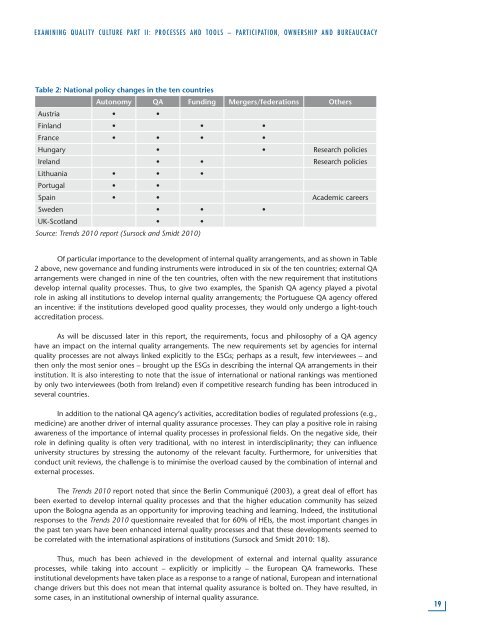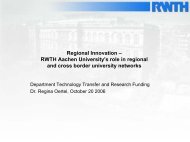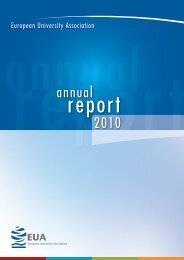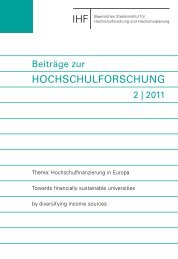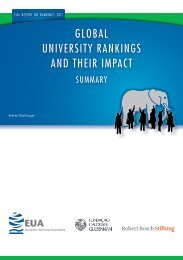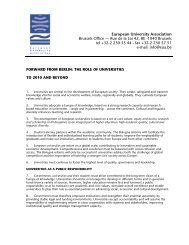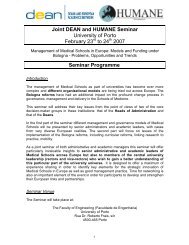Examining Quality Culture Part II: - European University Association
Examining Quality Culture Part II: - European University Association
Examining Quality Culture Part II: - European University Association
You also want an ePaper? Increase the reach of your titles
YUMPU automatically turns print PDFs into web optimized ePapers that Google loves.
ExAmININg QUALITy CULTUrE PArT <strong>II</strong>: PrOCESSES ANd TOOLS – PArTICIPATION, OwNErShIP ANd BUrEAUCrACy<br />
Table 2: National policy changes in the ten countries<br />
Autonomy QA Funding Mergers/federations Others<br />
Austria • •<br />
Finland • • •<br />
France • • • •<br />
Hungary • • Research policies<br />
Ireland • • Research policies<br />
Lithuania • • •<br />
Portugal • •<br />
Spain • • Academic careers<br />
Sweden • • •<br />
UK-Scotland • •<br />
Source: Trends 2010 report (Sursock and Smidt 2010)<br />
Of particular importance to the development of internal quality arrangements, and as shown in Table<br />
2 above, new governance and funding instruments were introduced in six of the ten countries; external QA<br />
arrangements were changed in nine of the ten countries, often with the new requirement that institutions<br />
develop internal quality processes. Thus, to give two examples, the Spanish QA agency played a pivotal<br />
role in asking all institutions to develop internal quality arrangements; the Portuguese QA agency offered<br />
an incentive: if the institutions developed good quality processes, they would only undergo a light-touch<br />
accreditation process.<br />
As will be discussed later in this report, the requirements, focus and philosophy of a QA agency<br />
have an impact on the internal quality arrangements. The new requirements set by agencies for internal<br />
quality processes are not always linked explicitly to the ESGs; perhaps as a result, few interviewees – and<br />
then only the most senior ones – brought up the ESGs in describing the internal QA arrangements in their<br />
institution. It is also interesting to note that the issue of international or national rankings was mentioned<br />
by only two interviewees (both from Ireland) even if competitive research funding has been introduced in<br />
several countries.<br />
In addition to the national QA agency’s activities, accreditation bodies of regulated professions (e.g.,<br />
medicine) are another driver of internal quality assurance processes. They can play a positive role in raising<br />
awareness of the importance of internal quality processes in professional fields. On the negative side, their<br />
role in defining quality is often very traditional, with no interest in interdisciplinarity; they can influence<br />
university structures by stressing the autonomy of the relevant faculty. Furthermore, for universities that<br />
conduct unit reviews, the challenge is to minimise the overload caused by the combination of internal and<br />
external processes.<br />
The Trends 2010 report noted that since the Berlin Communiqué (2003), a great deal of effort has<br />
been exerted to develop internal quality processes and that the higher education community has seized<br />
upon the Bologna agenda as an opportunity for improving teaching and learning. Indeed, the institutional<br />
responses to the Trends 2010 questionnaire revealed that for 60% of HEIs, the most important changes in<br />
the past ten years have been enhanced internal quality processes and that these developments seemed to<br />
be correlated with the international aspirations of institutions (Sursock and Smidt 2010: 18).<br />
Thus, much has been achieved in the development of external and internal quality assurance<br />
processes, while taking into account – explicitly or implicitly – the <strong>European</strong> QA frameworks. These<br />
institutional developments have taken place as a response to a range of national, <strong>European</strong> and international<br />
change drivers but this does not mean that internal quality assurance is bolted on. They have resulted, in<br />
some cases, in an institutional ownership of internal quality assurance.<br />
19


